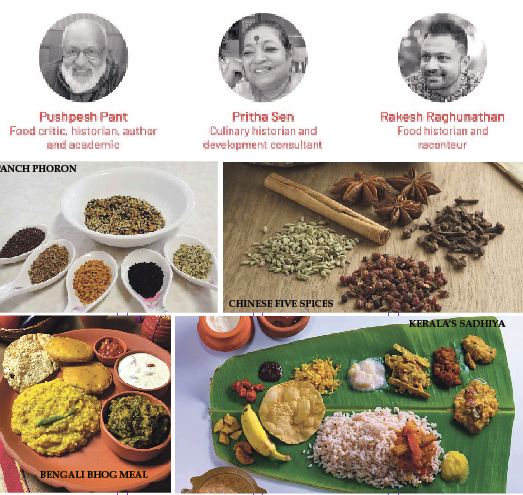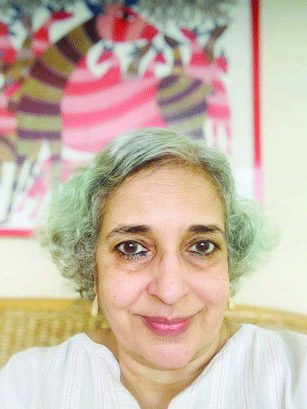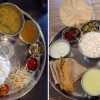Goa is abuzz with excitement as vintage bike and car owners, users, collectors and fans are decking […]

DOES FOOD UNITE US INTO LIVING IN HARMONY?
Eating is Fun / Eating is Yuck! - A variety food column, Jan 01- Jan 07, 2022 December 31, 2021Asian Affinities in India’s Culinary Heritage webinar: A most amazing discussion came to the conclusion that when it comes to Indian food… it is widely influenced by Asian & Occidental ingredients and recipes!
By Tara Narayan
IN our currently troubled times in the country it made perfect sense to catch a celebration of food meeting organised on the occasion of the release of the art magazine of old MARG. The virtual meeting was to mark the 75th anniversary issue (Sept-Dec 2021) and the talk was titled “Asian Affinities in India’s Culinary Heritage.” I was invited to attend the virtual meeting online and I registered but didn’t catch it, but my Bengaluru-based friend Prema Viswanathan, who was moderating the meeting, later sent me link and I am so grateful for it!
So I managed to catch up with a most tantalizing talk about India’s vast culinary heritage, which links us all together across South Asia, South East Asia, East Asia…China, Cambodia, Thailand, Burma, Sri Lanka – in short, a very vast canvas. All of it rooted amongst other things the history of the Silk Route and marine time trading spice routes and when European colonies flourishing there was a lot of movement of flora and fauna (fauna?) and of course the spices which travelled the world and emerged as one of the unifying factors of life beyond colonial empires. Timeless food!
It was a very engaging conversation which went on around courtesy such notable persons as the learned, down-to-earth Prof Pushpesh Pant (food critic, historian, author), Bengali food afficianado Pritha Sen (food historian, development consultant), Rakesh Raghunathan (food historian, raconteur, student of food down south India and Tamil Sangam literature). The discussion was moderated by the very vivacious journalist-author Prema Viswanathan and this took place on Friday, December 17, 2021 from 7pm to 8.30pm.
Prema kindly posted me a recording and listening to it brought home to me how food has played such a transforming, unifying role in our contemporary, global lives – and at the same time the question arises, why is food becoming so divisive in today’s times? I mean the saga of food across time and space is such an enlightening, liberating education. But Prof Pant admits food has always been divisive in history despite what we like to think.
But then again see how today’s vegetarians were yesterday’s non-vegetarians when times were tough and there was no time for fixing glamorous vegetarianism. In cold, hostile places, where invasions and conquests played out world history – folk would have died if they depended on vegetarian to survive!
VEGETERIAN FISH
Someone said the Brahmins of undivided Bengal thought fish was vegetarian because it was the fruit of the sweet river waters. The history of Bengal itself is so interesting considering its British colonisation and subsequent partition into West and East Bengal – and nobody can know more about this than Pritha Sen, who amongst other things offered an insight into how history influenced the coming together of such things as the famed Bengali “panch poran” – a spice mix which flavours many a Bengali recipe (panch poran is equal mix of mustard seeds, cumin seeds, methi seeds, aniseeds and onion seeds, it makes for a gloriously flavorful tempering for sabzi or dal).
In China too they have a traditional five spice mix used to season and cook – the number five is considered specially auspicious in Bengali tradition and cuisine and see how one of the spices, onion seeds or “raduni” is used almost exclusively in Bengali and Oriental cuisines. There is so much to Bengali cuisine West and in the larger context of East Bengal, Bangladesh today.
VARIED INFLUENCERS
THEN there were the Portuguese and British culinary influences which took place in an undivided Bengal when it was the seat of the British Empire which stretched to the Malaysian Straits Settlements and further… all the giving and taking which went on across colonies made for a culinary affair worth noting and appreciating. There are the earlier Moghal influences coming from Central Asia, and Buddhist influences – don’t believe that Buddhists have ever been vegetarian, it’s been to Japan and back across a China where meat and seafood eating is essentially part of the cultural ethos and flourishing markets.
In many temples of South East Asia prasadam or sacred offering to the gods comprise of meat offering – so all this talk of pork and beef being sacred or not sacred is the imagined nonsense of recent times. Eating habits as they have evolved have a very vast palate! It has spawned and shared synergies and eco-diversity across Asia and created so many affinities. In this context Indian food is not exclusive Indian food – it is and it is not, indeed, there are so many paradoxes, too many for anyone to feel superior about when it comes to my high-brow eating habits and your low-brow eating habits or so to speak.
HOW MANY CURRIES!
I MEAN as Rakesh Raghunathan observed, look at how the basic curry has evolved over time, presumably from south India where black pepper, dark green curry leaves and tamarind define a lentil curry. Today how many curries there are pan-Asia? In fact, the British Raj went back home to England to suffer nostalgia about all the spiced up curries their palate took a shine too while out in their erstwhile colonies stretching from India to South East Asia.
Very often culinary habits evolved through hard times and so I think it was Pritha who noted that the Bengali love for poppy seeds or “posto” was when the British cultivated poppy fields for deriving opium to drug the Chinese senseless! Posto or poppy seeds were a waste product of poppy cultivation, shared the food historian. Indeed, Bengal which is akin to being a country by itself, has survived several shocks and witnessed some terrible suffering courtesy British colonial exploitation (remember Satyajit Ray’s film Pather Panchali).
BENGAL & KERALA
COME to think about it how much do we know about China’s history in India, it is every bit as mesmerising as the history of many other nations. I find the amalgamation of Bengali cuisine particularly fascinating… it seems, no, it does not only seem, there’re perfectly good reasons why Bengali cuisine East and West Bengal, resonate with the cuisine of Kerala. The states have so much in common including climatic conditions. The discussion saw a sharing of notes about the auspicious Bengali “bhog” and Kerala “sadya” meals where possibly every recipe has a story to tell.
Rakesh Raghunathan spoke about the touchstone of Tamilian cuisine as evoked in the Sangam literature of Tamil culture… today who doesn’t like the savoury “ven pongal” with Kerala’s “avial” – compare this with the Bengali Durga Puja time “bhog kichuri.” Both are basically rice recipes but “pongal” is always a mixture of “moong dal and rice” regardless of whether there are veggies or no veggies. In fact, perhaps the rice came in much later as also the pristine “idli” itself which has many songs to sing from near and far. The Kanchipuram idli, he says, is a recipe in which several pieces of history come together!
Also, from where do the cooking techniques of steaming and fermenting foods come? The Bengali “kichuri” is more exotic and will feature a variety of veggies but no onion and garlic. Then don’t we associate the Malayalam “avial” of veggies with “pongal” – a marriage between Tamil and Malayalam culinary history?
ALL this and much more including the overwhelming finale of widespread love for the humble leaf of the betal leaf and betal nut scrapings in a roll-call of “paan” – it’s a habit which links Indians across the sub-continent! Why did Indians fall for the habit of chewing “paan”— both a post-prandial mouth refresher and mild aphrodisiac, cheer me up habit? There is no economic context here for paan-chewing is as humble as it can get and as indulgent as sweet “magai”– paan-chewing caught on in India and across Indian borders eastwards. Say, it is yet another example of give and take across history to arrive at Asian affinities in India’s culinary heritage!
Asks Prof Pant, Did it ever occur to us in India that the tandoori way of cooking comes to us in the undivided India of old from Central Asia? It is all the culinary synergies of history which make Asian food so indivisible today, “Food is the making of the Indian nation!” Indian food cannot be separated from Asian food and we must not forget our “historical memories.” Especially today when as Prema Vishwanathan summed up, there is much talk of divisive purity! Hey, there can be no nationalism on the subject of food please and there I would endorse all the speakers in this thought-provoking discussion.
We in India celebrate diverse cuisines from state to state as also as tribute to history’s gifts making for an extraordinary bounty worthy of celebration. Pritha Sen has it right when she says, connect the dots, “food is just seamless synergy assimilation” through the Eastern belt from China down to Tibet, Nepal, West Bengal and South East Asia…with entire synergetic exchange happening all the time food is evolving philosophy, all exchange enrich a region, all Asia.
ALL this is to say you may find it worthwhile to catch up with this “Asian Affinities in India’s Culinary Heritage” discussion over U-tube! Even more worthwhile would be to get the latest copy of MARG’s 75th anniversary issue.

THE art of culinary creation has occupied pride of place in Marg’s 750 year history. Several issues of the magazine have explored the richness and diversity of India’s cuisines, focussing on the geographical, historical, social, political and economic dimensions of this art as it manifested itself in the sub-continent as well as in the rest of Asia. The Silk Road and the maritime spice route ensured that ingredients and dishes travelled to the countries in Southeast Asia and the Far East where the local people embraced and adapted them. I was myself astounded by the extent to which the roti-prata” had inveigled itself into the eating culture of Singapore, where I lived for close to 25 years. The Indian culinary heritage has earned abundant praise from even the British colonisers who revelled in the rich spice laden feasts that India offered up until the “Memsahib era”, as Shalini Holkar puts it, when nostalgia for the food back home created a growing antipathy towards the Indian cuisine. But, as our panellist Pushpesh Pant points out in the current issue of Marg, the reverse trend could also be seen. The ability of the Indian palate to adapt and assimilate resulted in an explosion in creativity on the food front. Thus, we had dishes from Southeast Asia such as Malaysian style prawn rice., Thai style kheema biryani and the ubiquitous betel leaf making their way into India. There was also the Portuguese overlay on the Goan cuisine, the Persian influence on the Lucknowi kebabs and biryanis and the transformation of Chinese dishes in the by-lanes of Kolkata. In more recent times we have also seen the rising popularity of fusion food, as well as the crossover of regional cuisines – all contributing to the creation of a syncretic social fabric. However, even as we celebrate the contribution of our culinary heritage to social cohesion, we cannot ignore its divisive role in entrenching and at times, even accentuating, the social, communal and economic divide in the country. The concept of “purity” and the food taboos that it has engendered, have reinforced casteism in India. Thus even in a temple in Udipi, you have a separate room where Brahmins are served. The invisibility of some cuisines – eg the dishes Dalits and Adivasis eat – in our overarching culinary discourse, is another example of the social divide. And on the economic front, the linkage of food or financial status is evident in the way poverty denies people the right to our culinary heritage. But most alarming is the communal colouring that the discourse on food has taken on. The violence that has erupted over the consumption of beef is one manifestation of the polarising tendencies that are threatening to subsume our syncretic culinary practice. Hopefully, these concerns can be addressed and resolved in the interests of preserving our rich food heritage. We have among our panellists today historians as well as practitioners, which should make for a stimulating discussion on the celebrations and preservation of our precious heritage.















